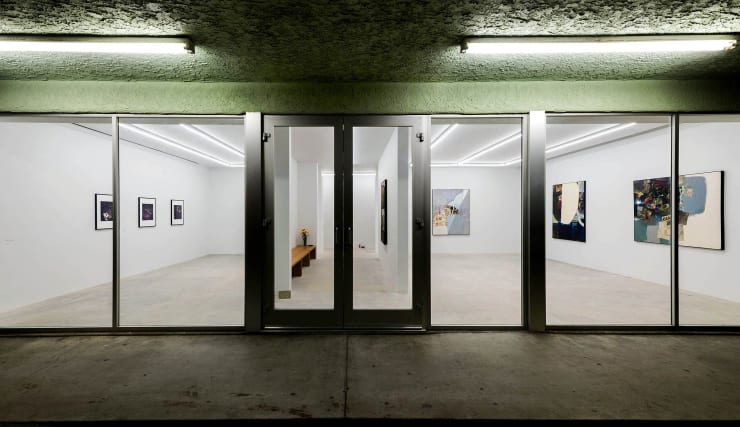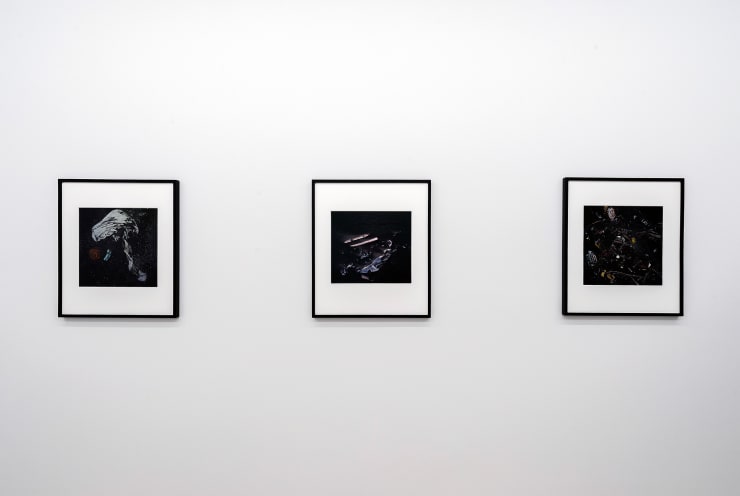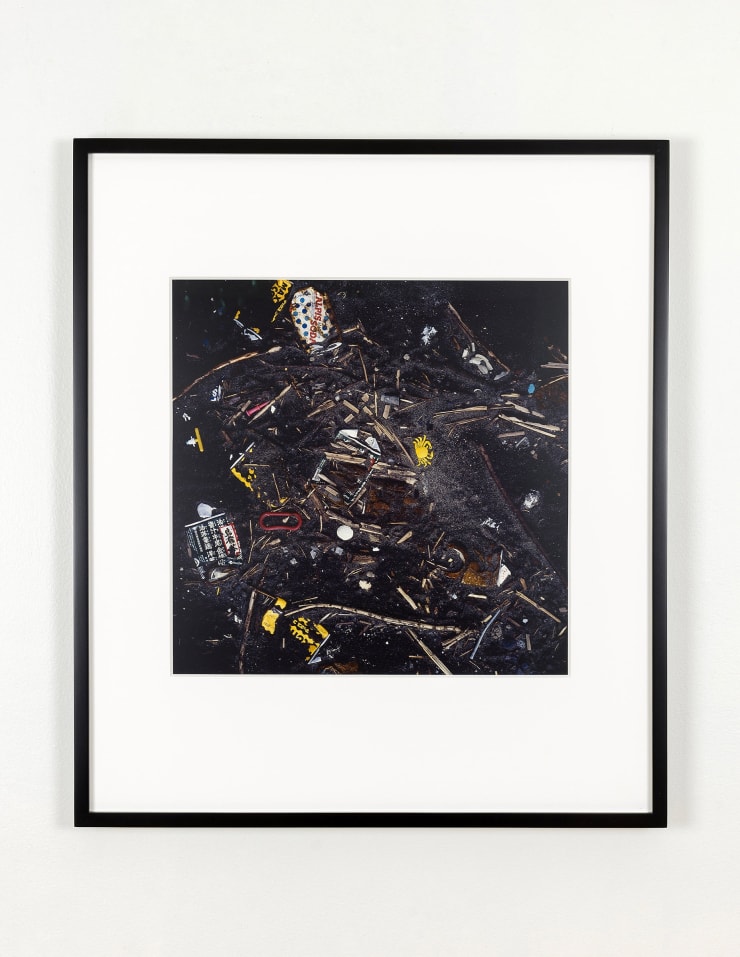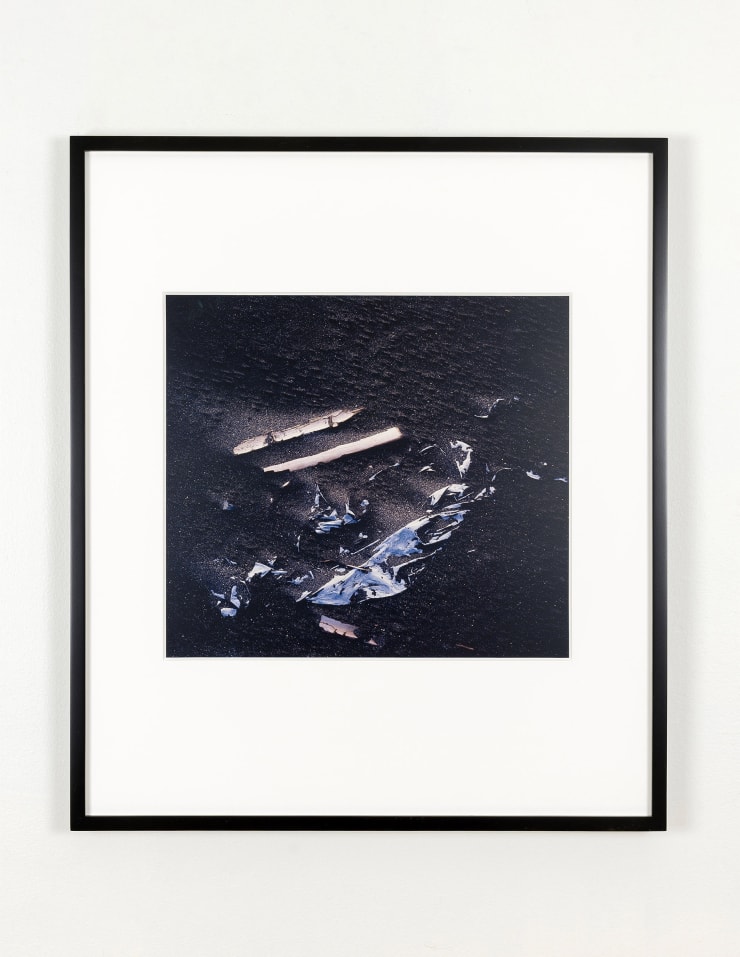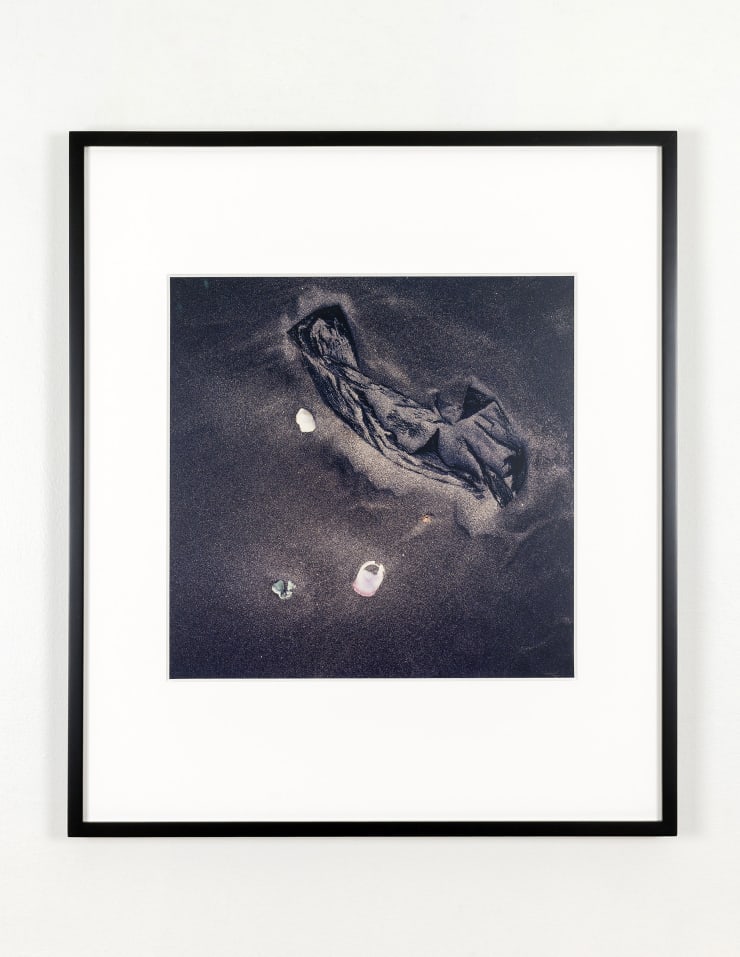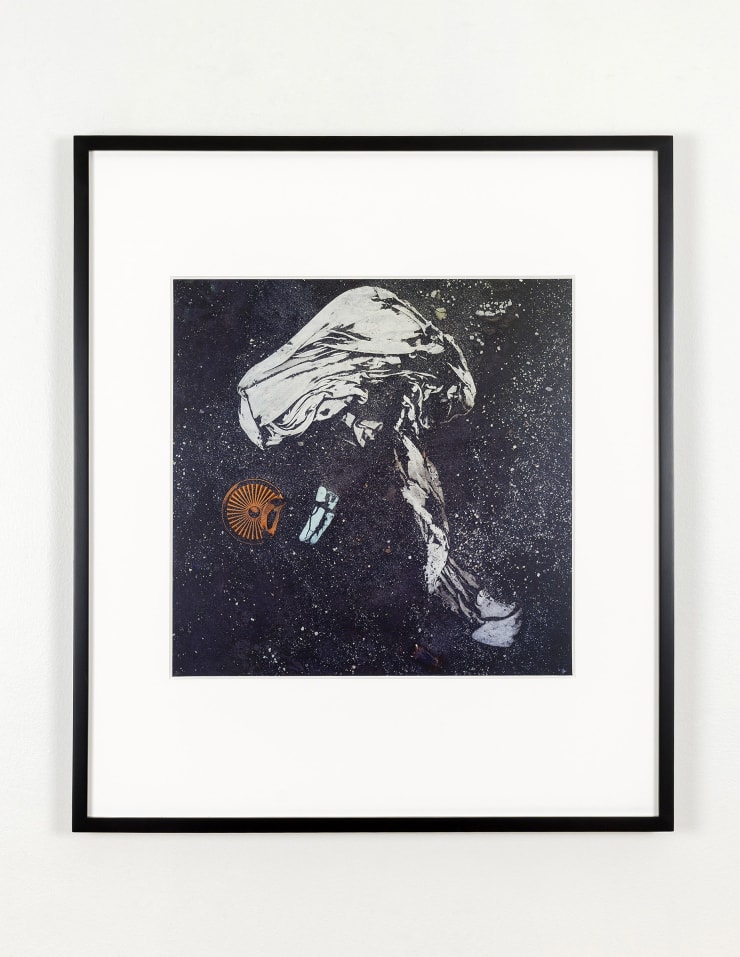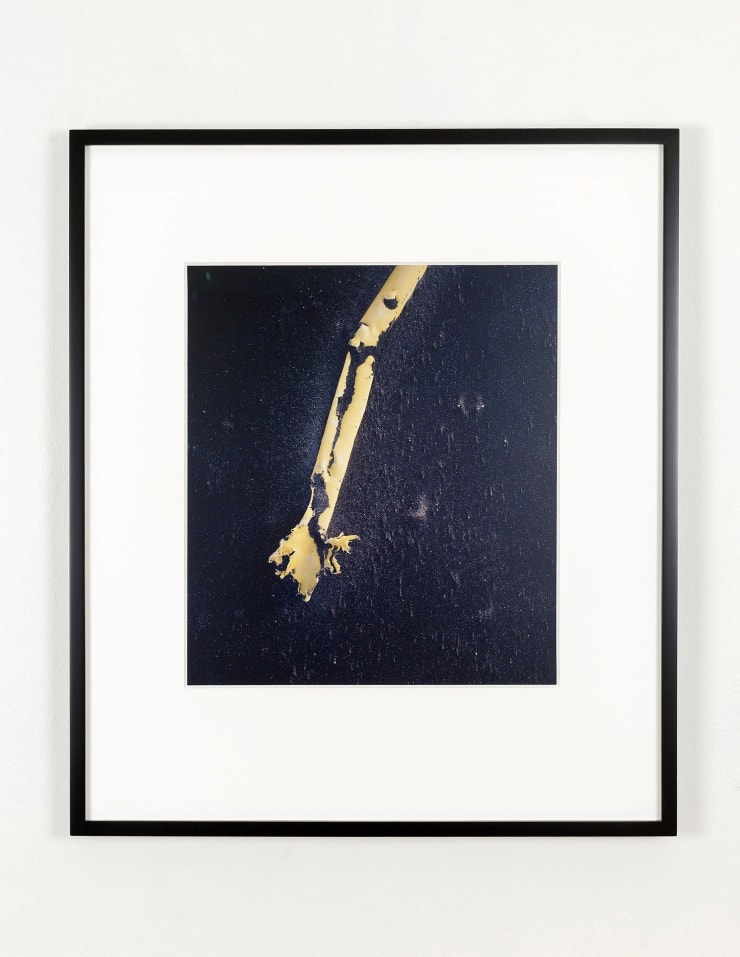Shomei Tomatsu: Plastics
42 x 42 cm
Press:
Contemporary Art Daily, June 26, 2018
KCRW, June 14, 2018
Nonaka-Hill is pleased to present the first Los Angeles solo exhibition of photographs by Shomei Tomatsu.
Born in Nagoya in 1930, Tomatsu was a teenager during WWII. Ignoring the air-raid sirens, Tomatsu positioned a mirror so that he could witness the B-29 bombers, “a feast of metallic beauty”, as they destroyed 90 percent of built Nagoya. This memory of a nocturnal “pageant of light” in the sky influenced the compositions of his 1960s “Asphalt” series, a format that Tomatsu revisits in the “Plastics” series, on view here. Shomei Tomatsu is widely regarded as a preeminent photographer of Japan’s post-war period. In a life work chronicled six decades of a changing Japan, he produced several of his country’s best-known, often poignant images. Tomatsu began taking photographs in 1950, and by 1952 he had received praise from established photographers Ken Domon and Ihei Kimura. Initially working as a photojournalist, Tomatsu’s images were more staged and poetic than the refined objectivity seen in the work of his predecessors. Between 1959-61, Tomatsu founded the legendary VIVO photographic agency (with Kikuji Kawada, Akira Sato, Akira Tanno, Ikko Narahara and Eikoh Hosoe) and founded the “Workshop” photography school (with Nobuyoshi Araki, Masahisa Fukase, Eikoh Hosoe, Daido Moriyama and Noriaki Yokosuka). In 1958, Tomatsu began his “Chewing Gum and Chocolate” series, in which he studied the impact of American occupation on Japan. And, in 1961, Tomatsu co-authored the acclaimed “Hiroshima-Nagasaki Document” with Ken Domon, which exposed the lingering effects of the atomic bombs, 16 years after the events. Photographer and essayist, Leo Rubenfien described Tomatsu's Nagasaki photographs as "sad, haggard facts", noting that, as Tomatsu wandered with his camera, "beneath the surface there was a grief so great that any overt expression of sympathy would have been an insult." Of his experience, Tomatsu explained: ”In 1945, its cities devastated, Japan was inundated with American soldiers,“ he wrote. ”We were starving, and they threw us chocolate and chewing gum. That was America. For better or worse, that’s how I encountered America.” Through his his widely published works and engagement in the photographic community, Tomatsu’s expressionistic stance influenced the younger generations, including photographers of the “Provoke era”, Nobuyoshi Araki, Takuma Nakihara and Daido Moriyama, who said: “For me as a photographer, without a doubt, everything began with Tomatsu.” Tomatsu’s work was first seen in the United States in 1974, when Museum of Modern Art, New York presented New Japanese Photography*. The exhibition co-curator, John Szarkowsky referred to Tomatsu as “the pivotal figure of recent Japanese photography”, whose images are "an intuitive response to the experience of life itself". Szarkowski also explained “It was not the rejection of traditional journalism, but the acceptance of a larger and more difficult problem, that defines Tomatsu's identity as a photographer."
Shomei Tomatsu produced his “Plastics” series in 1987-89, and seven examples are on view here. Tomatsu, in middle-age at the time, was recovering from heart surgery, walking the beaches near his home in Chiba, Japan. His camera captured random bits of colorful detritus, set against the black, glistening sands. These photos recall Tomatsu’s Asphalt series from 1960, made in his youth while walking the streets, photographing lost and fallen shiny objects imprinted into soft black asphalt, appearing almost as fossils, or the night-time sky of his war-time youth. Both series document the imprints of human activity, and evoke the artist’s existential considerations. In 1992, The Metropolitan Museum of Art, New York presented “Photographs by Shomei Tomatsu: Sakura + Plastics”, the museum’s first exhibition dedicated to the work of a living Japanese artist. The two series, shown together, project the artist’s bittersweet relationship with his nation, which saw massive cultural change in his lifetime. Sakura (cherry trees) have been celebrated annually for thousands of years with ritual “Hana-mi” (flower viewing), and remain a symbol of Japanese cultural identity, though the military’s sakura emblem was retired with the war defeat. Tomatsu’s images of the iconic Sakura subject range from intoxicating florals to abject compromise. For his book: “Views of Japan: Tomatsu Shomei”, the artist selected the “Plastics” series as the volume’s sole imagery. After “Plastics”, Tomatsu moved to Nagasaki and to Okinawa, returning to the places where the black and white photographs of his youth were taken. He explored Japan’s southern Ryukyu islands, home to so much American military, coexisting with native islanders, flora and fauna, and produced vividly colorful photographs, recently exhibited at Art Institute of Chicago in Shomei Tomatsu: Island Life.
Shomei Tomatsu, born 1930, Nagoya, Japan, died 2012, Naha, Okinawa, Japan Major solo exhibitions include: “Shomei Tomatsu: Island Life”, Art Institute of Chicago (2013), “Tomatsu Shomei: Photographs,” Nagoya City Art Museum (2011), “Tomatsu Shomei: Tokyo Mandala,” Tokyo Metropolitan Museum of Photography (2007), “Aichi Mandala: Tomatsu Shomei’s Landscape,” Aichi Prefectural Museum of Art, Nagoya (2006), “Okinawa Mandala,” Urasoe Art Museum (2002), “Shomei Tomatsu: Skin of the Nation” organized by San Francisco Museum of Modern Art, touring venues in America and Europe (2004-2007), “Interface,” The National Museum of Modern Art, Kyoto (2004), “Nagasaki Mandala,” Nagasaki Prefectural Art Museum (2000), “Traces: Fifty Years of Tomatsu’s Work,” Tokyo Metropolitan Museum of Photography (1999) Among his major awards are the Japan Photo Critics Association Newcomer’s Award (1958), the Japan Photo Critics Association Artist Award (1961), the Mainichi Art Award (1976), The Minister of Education, Science and Culture’s Art Encouragement Prize (1976), The Medal with Purple Ribbon (1995) and The Photographic Society of Japan Distinguished Contributions Award (2005).
“A photographer looks at everything, which is why he must look fron the beginning to end, face the subject head-on, stare fixedly, turn the entire body into an eye and face the world.” – Shomei Tomatsu
 Shomei TomatsuPlastics, Kujukuri Beach, Chiba, 1988-89/1989Chromogenic print, mounted on aluminum.16-1/2 x 16-1/2 inches
Shomei TomatsuPlastics, Kujukuri Beach, Chiba, 1988-89/1989Chromogenic print, mounted on aluminum.16-1/2 x 16-1/2 inches
42 x 42 cm Shomei TomatsuPlastics, Kujukuri Beach, Chiba, 1988-89/1989Chromogenic print, mounted on aluminum.15-1/2 x 16-7/8 inches
Shomei TomatsuPlastics, Kujukuri Beach, Chiba, 1988-89/1989Chromogenic print, mounted on aluminum.15-1/2 x 16-7/8 inches
38.4 x 42.9 c Shomei TomatsuPlastics, Kujukuri Beach, Chiba, 1988-89/1989Chromogenic print, mounted on aluminum.16-1/2 x 16-1/2 inches
Shomei TomatsuPlastics, Kujukuri Beach, Chiba, 1988-89/1989Chromogenic print, mounted on aluminum.16-1/2 x 16-1/2 inches
41.9 x 41.9 cm Shomei TomatsuPlastics, Kujukuri Beach, Chiba, 1988-89/1989Chromogenic print, mounted on aluminum.16-5/8 x 16-5/8 inches
Shomei TomatsuPlastics, Kujukuri Beach, Chiba, 1988-89/1989Chromogenic print, mounted on aluminum.16-5/8 x 16-5/8 inches
42.2 x 42.2 cm Shomei TomatsuPlastics, Kujukuri Beach, Chiba, 1988-89/1989Chromogenic print16-1/2 x 16-1/2 inches
Shomei TomatsuPlastics, Kujukuri Beach, Chiba, 1988-89/1989Chromogenic print16-1/2 x 16-1/2 inches
41.9 x 41.9 cm Shomei TomatsuPlastics, Kujukuri Beach, Chiba, 1988-89/1989Chromogenic print, mounted on aluminum.16-1/2 x 16-1/2 inches
Shomei TomatsuPlastics, Kujukuri Beach, Chiba, 1988-89/1989Chromogenic print, mounted on aluminum.16-1/2 x 16-1/2 inches
42 x 42 cm Shomei TomatsuPlastics, Kujukuri Beach, Chiba, 1988-89/1989Chromogenic print, mounted on aluminum.17-1/4 x 15-1/4 inches
Shomei TomatsuPlastics, Kujukuri Beach, Chiba, 1988-89/1989Chromogenic print, mounted on aluminum.17-1/4 x 15-1/4 inches
43.9 x 38.8 cm
-

-

-

-

-

-

-
 Shomei Tomatsu, Plastics, Kujukuri Beach, Chiba, 1988-89/1989
Shomei Tomatsu, Plastics, Kujukuri Beach, Chiba, 1988-89/1989 -

Shomei Tomatsu, Plastics, Kujukuri Beach, Chiba, 1988-89/1989
-

Shomei Tomatsu, Plastics, Kujukuri Beach, Chiba, 1988-89/1989
-

Shomei Tomatsu, Plastics, Kujukuri Beach, Chiba, 1988-89/1989
-

Shomei Tomatsu, Plastics, Kujukuri Beach, Chiba, 1988-89/1989
-

Shomei Tomatsu, Plastics, Kujukuri Beach, Chiba, 1988-89/1989
-

Shomei Tomatsu, Plastics, Kujukuri Beach, Chiba, 1988-89/1989
Related artist
Artist Exhibited:
Ulala Imai
Kazuo Kadonaga
Kentaro Kawabata
Zenzaburo Kojima
Kisho Kurokawa
Tadaaki Kuwayama
Toshio Matsumoto
Keita Matsunaga
Yutaka Matsuzawa
Kimiyo Mishima
Kunié Sugiura
Takuro Tamayama
Tiger Tateishi
Sofu Teshigahara
Shomei Tomatsu
Wataru Tominaga
Hosai Matsubayashi XVI
Kansuke Yamamoto
Masaomi Yasunaga
Exhibitions:
-2025-
KEY HIRAGA: The Elegant Life of Mr. H
-2024-
KYOKO IDETSU: What can an ideology do for me?
KENTARO KAWABATA / BRUCE NAUMAN
SAORI (MADOKORO) AKUTAGAWA: CENTENARIA
Keita Matsunaga : Accumulation Flow
-2023-
NONAKA-HILL ♥ TATAMI ANTIQUES: A holiday sale of unique objects from Japan
TAKASHI HOMMA : REVOLUTION No.9 / Camera Obscura Studies
TATSUMI HIJIKATA THE LAST BUTOH: Photographs by Yasuo Kuroda
Kiyomizu Rokubey VIII: CERAMIC SIGHT
Masaomi Yasunaga: 石拾いからの発見 / discoveries from picking up stones
SHUZO AZUCHI GULLIVER ‘Synogenesis’
Koichi Enomoto: Against the day
Tatsuo Ikeda / Michael E. Smith
Hiroshi Sugito: the garden with Zenzaburo Kojima
Zenzaburo Kojima: This very green
Tomohisa Obana: To see the rainbow at night, I must make it myself
Daisuke Fukunaga: Beautiful Work
- 2021 -
Natsuyasumi: In the Beginning Was Love
Takashi Homma: mushrooms from the forest
– 2020 –
Hosai Matsubayashi XVI & Trevor Shimizu
Sterling Ruby and Masaomi Yasunaga
– 2019 –
A show about an architectural monograph
Yutaka Matsuzawa
Yutaka Matsuzawa through the lens of Mitsutoshi Hanaga
Takuro Tamayama & Tiger Tateishi
Kunié Sugiura
Masaomi Yasunaga
Miho Dohi
Wataru Tominaga
Naotaka Hiro
Parergon: Japanese Art of the 1980s and 1990s
Tadaaki Kuwayama
– 2018 –
Toshio Matsumoto
Kentaro Kawabata
Kansuke Yamamoto
Kazuo Kadonaga: Wood / Paper / Bamboo / Glass
Press:
-2025-
Artillery Magazine, Sawako Goda
-2024-
Artsy, Nonaka-Hill
Richesse, Nonaka-Hill Kyoto
Bijutsutecho, Nonaka-Hill Kyoto
The Art Newspaper, Nonaka-Hill Kyoto
Meer, Kyoko Idetsu
Bijyutsutecho, Masaomi Yasunaga
Switch, Masaomi Yasunaga
ARTnews JAPAN, Masaomi Yasunaga
Richesse, Masaomi Yasunaga
Art Basel, Daisuke Fukunaga, Imai Ulala
Art Basel, Kazuo Kadonaga, Sofu Teshigahara
-2023-
ADF webmagazine, Yasuo Kuroda, Tatsumi Hijikata
e-flux, Sanya Kantarofsky, Yasuo Kuroda
Los Angeles Times, Kenzi Shiokava
Artillery, Masaomi Yasunaga
Contemporary Art Daily Shuzo Azuchi Gulliver
- 2022 -
Contemporary Art Daily, Tomohisa Obana
ARTE FUSE, Daisuke Fukunaga
Contemporary Art Daily, Daisuke Fukunaga
Contemporary Art Review Los Angeles (Carla), Daisuke Fukunaga
What's on Los Angeles, Daisuke Fukunaga
Hyperallergic, Daisuke Fukunaga
Artillery, Kentaro Kawabata
Larchmont Buzz, entaro Kawabata
- 2021 -
Art Viewer, Natsuyasumi: In the Beginning Was Love
Hyperallergic, Natsuyasumi: In the Beginning Was Love
Art Viewer, Takashi Homma
Hyperallergic, Busy Work at Home
Art Viewer, Busy Work at Home
Hyperallergic, Ulala Imai
Contemporary Art Review Los Angeles (Carla), Ulala Imai
Contemporary Art Daily, Ulala Imai
artillery, Ulala Imai
Special Ops, Ulala Imai
Art Viewer, Ulala Imai
artillery, Matsubayashi & Trevor Shimizu
– 2020 –
Ceramic Now, Sterling Ryby and Masaomi Yasunaga
Hypebeast, Sterling Ryby and Masaomi Yasunaga
Art Viewer, Sterling Ruby and Masaomi Yasunaga
Air Mail, Sterling Ruby and Masaomi Yasunaga
Los Angeles Times, Kaz Oshiro
ArtnowLA, Kaz Oshiro
What's on Los Angeles, Kaz Oshiro
KCRW, Kaz Oshiro
Tique, Kaz Oshiro
Contemporary Art Daily, Kaz Oshiro
Art Viewer, Kaz Oshiro
Contemporary Art Daily, Sofu Teshigahara
Art Viewer, Sofu Teshigahara
KCRW, Sofu Tsshigahara
Hyperallergic, Nonaka-Hill
Los Angeles Times, Keita Matsunaga
– 2019 –
Los Angeles Times, Tatsumi Hijikata
Art Viewer, Tatsumi Hijikata, Eikoh Hosoe
Contemporary Art Review Los Angeles, Tatsumi Hijikata, Eikoh Hosoe
ArtAsiaPacific, Yutaka Matsuzawa
Los Angeles Times, Tatsumi Hijikata
AUTRE, Tatsumi Hijikata, Eikoh Hosoe
Los Angeles Times, Nonaka-Hill
ARTFORUM, Takuro Tamayama, Tiger Tateishi
Art Viewer, Takuro Tamayama, Tiger Tateishi
KCRW, Nonaka-Hill
LA WEEKLY, Nonaka-Hill
AUTRE, Takuro Tamayama, Tiger Tateishi
ArtsuZe, Takuro Tamayama, Tiger Tateishi
ARTFORUM, Review: Tadaaki Kuwayama, Rakuko Naito
Art Viewer, Masaomi Yasunaga, Kunié Sugiura
Los Angeles Times, Masaomi Yasunaga
KQED, Tadaaki Kuwayama, Rakuko Naito
Contemporary Art Daily, Naotaka Hiro, Wataru Tominaga, Miho Dohi
Los Angeles Times, Miho Dohi
Los Angeles Review of Books, Miho Dohi
Bijutsu Techo, Naotaka Hiro, Wataru Tominaga, Miho Dohi
Art Viewer, Miho Dohi
Art & Object, Parergon
COOL HUNTING, Felix Art Fair
Art Viewer, Tadaaki Kuwayama
artnet news, Nonaka-Hill
Contemporary Art Review Los Angeles (Carla), Tadaaki Kuwayama
– 2018 –
Art Viewer, Kentaro Kawabata
Contemporary Art Daily, Kazuo kadonaga
Los Angeles Times, Kazuo Kadonaga
ARTFORUM, Kazuo Kadonaga
Contemporary Art Daily, Shomei Tomatsu
KCRW, Kimiyo Mishima, Shomei Tomatsu
This website uses cookies
This site uses cookies to help make it more useful to you. Find out more about cookies.









